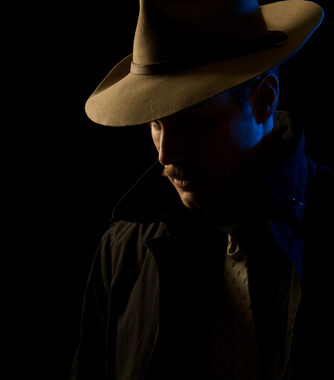James Crumley in Print (and Now on Screen?)
The recent rumors that Mel Gibson is looking to adapt the 1983 novel Dancing Bear by James Crumley for television is exciting news. Gibson, the force behind 2016’s Hacksaw Ridge, is in talks with Chinatown (1974) screenwriter Robert Towne and Black Swan (2010) producer Mike Medavoy to bring one of Crumley’s novels to the small screen. Why is this exciting news, you may ask? Because, finally, one of America’s most underrated crime writers has an opportunity to bring his hard-hitting work to cozy living rooms across the nation. At last, a crime writer with a remarkable body of work is being recognized for producing not simply “crime fiction” in the traditional sense, but for generating such a dark and violent vision of society that America emerges as the criminal of the piece.
Bringing together Towne and Medavoy is a master stroke by Gibson. The seediness of Towne’s Los Angeles, represented by the incestuous relationship between Noah Cross and his daughter, Evelyn Mulwray, combined with the dark, distrusting world of Medavoy’s Black Swan, will perfectly embody Crumley’s violent and alienating post-Vietnam Midwest environment.
And key to Crumley’s work is the location: set in Montana and later Texas. Crumley’s novels paint a harsh portrait of American society in the wake of the Vietnam War. Gibson’s description of the project as “basically Chinatown set in a 7-11 in Montana in the ’70s with a whole lot of cocaine” sums up the feel of the novels to a tee. His private eyes, Milton “Milo” Milodragovich and C.W. Sughrue, trawl a lawless frontier where the authorities are either corrupt or drowning in unsolved crimes. It is a society where, as Milo notes, “divorce, suicide and alcoholism rates […] embarrass […] the national average,” and kids “had begun to kill themselves with pills, speed and needles” (The Collection 66). Crumley describes a government that does not care for its citizens, is overrun with crime, ignores the pleas of its veterans, and is rotten to the core; every character we meet is a wino, a drug addict, a war veteran, or a dubious authority figure. As Milo says in Bordersnakes (1996), “All the people I knew were criminals, drunks, and bad-dog lawyers (169).
Crumley’s detectives suffer what Johannes Bertens and Theo D’Haen refer to as an “alienation that results from the fundamental incompatibility between the private eye’s moral ideal and the unruly reality of the world [they] live in” (Contemporary American Crime Fiction 2). They are characters alienated by the effects of war, drugs, drink, and oppositional politics and do their best to survive in a world that has altered beyond their recognition. Both are war veterans—Milo of Korea, Sugrue of Vietnam,—and their troubling experiences have caused drug addiction, alcohol dependency, nightmares, and flashbacks that continue to haunt them explicitly throughout the series of novels. And with the line between perpetrator and investigator becoming increasingly blurred in Crumley’s novels, his detectives are inevitably drawn into a noir existence. They get by with a live-and-let-live attitude and little regard for the law; the only things that matter to them are survival and quietening their demons with whatever drug they can lay their hands on. Unlike traditional detectives, their heroic quest is simply making it through the day.
Writing at a time when crime fiction was suffering a decline in popularity, Crumley’s work marked a significant shift in the structure of the genre during the 1970s, representative of an era in which the central crime committed became the war itself. Focusing upon corporate greed and blistering wartime anger, Crumley’s work confronts the traumatizing effects of the Vietnam War head-on by employing detectives explicitly characterized as war veterans in order to reveal the disillusionment and frustrations concerning the legality of the war and the subsequent treatment of American veterans. Crumley exposes a society ignorant of his characters’ trauma and directs his anger toward a government that abandoned its soldiers upon their return from combat. In his novels, Crumley incorporates a brutally explicit level of violence and seething underlying anger.
Crumely, himself a veteran of the Vientam War, published his first novel as a war novel, titled One to Count Cadence (1969). And his style, that bridges the gap between the war genre and crime fiction, absorbs the anger, discontent, and brutality of the era which is then used to attack an unsympathetic society, expose a corrupt state and reveal the utter despair of his characters. Confronting head-on the traumatizing effects of combat, he uses his war veteran protagonists to develop the genre by making the war the central aspect of the character’s lives, thereby driving the plots. Despite his detective series spanning 30 years, from his first detective novel, The Wrong Case, in 1975 to his final novel, The Right Madness, in 2005, the social and psychological impact of experiencing war is always what drives the Milo and Sughrue series. War is detailed in every novel, and over time becomes not simply a place, but instead adopts a weight of meaning that thirty years worth of trauma and disillusionment has given it.
Although he never published a bestseller, Crumley developed a large cult following and received tremendous critical acclaim. The disillusionment and anguish stemming from the war explicitly represented in his work highlights the nation’s hypocrisy and the state’s corruption. His novels, significantly, represent a brutal and progressively realistic representation of the American social landscape depicted through the eyes of traumatized war-veteran detectives.
And I, for one, can’t wait to see how Dancing Bear will look on screen!

